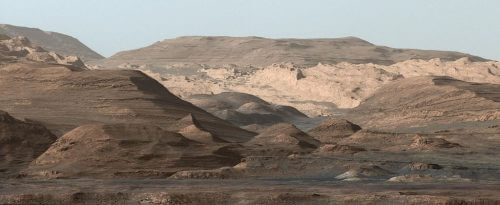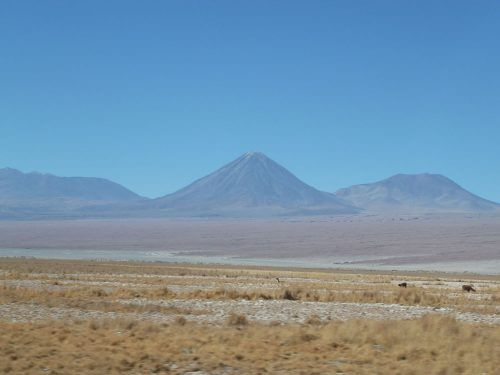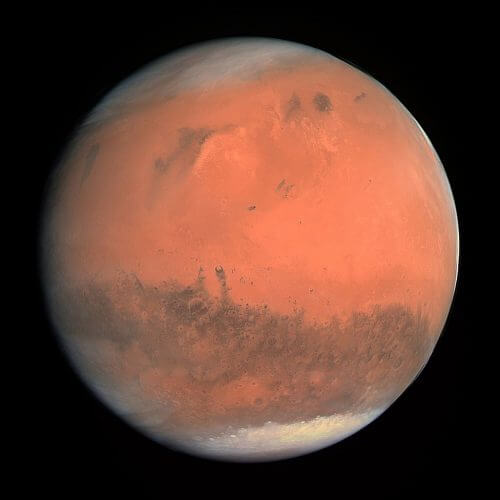For the first time ever, researchers have observed the formation of life in the world's driest desert, a fact that suggests that life could be hidden in the soil of the planet Mars

[Translation by Dr. Nachmani Moshe]
An international team of researchers, led by scientist Dirk Schulze-Makuch from Washington State University, studied the driest corner of the Atacama Desert in South America, an area where no rain has fallen in decades. Scientists have long wondered whether microbes found within the soil of this dry environment, the area on Earth most similar to the Martian terrain, are permanent residents or simply the dead remains of living things that drifted there from other regions. In a new study published in the scientific journal Proceedings of the National Academy of Sciences, the scientists revealed that even this very dry desert can provide an environment suitable for the home of microorganisms. The researchers found that a bacterium of a certain strain is able to live in the soil, and even become a permanent resident for decades, without using water, and then be reactivated and reproduce during rains.
"It's always fascinated me to go to places where people don't think life can exist and find that living things have found a way to take root there," said the lead researcher. "Without referring to the movie 'Jurassic Park', our research suggests that if life is possible in the driest environment on Earth, there is a pretty good chance that it is also possible on the planet Mars in a similar way."
When researchers arrived in the desert for the first time in 2015 to study how microorganisms survive in the driest soil on Earth, something strange happened. There were rain showers. After these rare showers, the researchers discovered a surge in biological activity within the desert soil. The scientists used sterile spoons and other sensitive tools to collect soil samples from different depths and then performed genomic analysis to identify the different strains of bacteria that multiplied in the samples.

The researchers found several local strains of bacteria that have adapted to live in the harsh environment. The researchers returned to the desert in 2016 and 2017 to follow up on their initial sampling and found that those bacterial strains that were in the soil gradually returned to their inactive, original state as soil moisture decreased.
"In the past, researchers have found dead organisms near the surface and remnants of their DNA, but this is really the first time any researcher has been able to identify a persistent form of life in the soil of the Atacama Desert," said the lead researcher. "We believe that there are strains of bacteria that are able to remain dormant for hundreds and maybe even thousands of years under conditions similar to those found on the surface of planets, such as Mars, and come back to life when rain showers appear."
Although living in the driest regions on Earth is difficult, the surface of the planet Mars is an even more brutal environment - it is much drier and colder. However, this situation was not always present. About billions of years ago, the planet Mars had small seas and lakes in which primitive life forms may have developed. As the planet dried out and became colder and colder, these organisms could evolve into the forms that adapted and survived even in the soil of the Atacama Desert. "We know that there is frozen water in the ground below the surface of Mars, and recent research suggests that snow that fell at night and other moisture-increasing events formed near the surface of the ground," explains the researcher. "If life at all developed on Mars, our research suggests that it could be found in a niche beneath the dry surface."

In March of this year, the researchers returned to the Atacama Desert for two weeks in order to investigate how the local creatures in this desert adapted and survived. The researchers also intend to study the creatures living in Lake Don Juan on the continent of Antarctica, an extremely shallow lake with such high salinity that it remains liquid even at a temperature of minus fifty degrees Celsius. "There are a small number of places on Earth that are worth looking for new life forms that survive in the conditions that exist on Mars," says the lead researcher. "Our goal is to understand how these creatures are able to exist there and then use those insights to understand what we should be looking for on the surface of the planet Mars."
See more on the subject on the science website:

12 תגובות
TR3B X22A
You notice you're babbling. What exactly do you eat forage or hay?
Gentlemen,
After all, it is known that there is life on the surface of Mars, which was already discovered when the first "Viking" landed in the seventies of the twentieth century. The life form on Mars was given the letters GMG, which are the initials of the scientific name given to them in Yiddish: "Gornisht mit Gornisht"!!! ? What to do, there is no life on Mars, and it is quite certain that if bacteria or viruses are discovered there (in the form of spores, of course, without active metabolism) - it is quite certain that they simply "caught a ride" on or inside the spacecraft that will "discover" them on Mars, and in fact it is almost certain that when they are exposed To the radiation of the "solar wind" and cosmic radiation, to vacuum (as mentioned, several hundredths of standard atmospheric pressure, as specified by Gal), to cold, etc. - they will die and not wake up like spores in much less harsh conditions that were discovered (and are still being discovered) in dry deserts and in salty lakes.
On the other hand, remember the animals called "water bears" - microscopic animals, which were launched into space by researchers at the Faculty of Agriculture in Rehovot several months ago, and survived several hours of exposure to space conditions: high vacuum, radiation and intense cold of only a few degrees Kelvin - but when they returned With the spaceship and landed on Earth they recovered and returned to normal life without any signs of distress...?
"Explore the driest corner of the Atacama Desert in South America, an area where no rain has fallen in decades"
"When researchers arrived in the desert for the first time in 2015 to study how microorganisms survive in the driest soil on Earth, something strange happened. There were rain showers"
Decide, if it also rained in 2015, how is this "an area where it hasn't rained in decades"?!
There is no possibility at all to compare the Earth with Mars, in the context of life
Being in the most difficult places of life is a paradise for the nation of Mars.
The huge differences are:
1. The atmosphere of Mars is one hundredth (0.01) of the atmospheric pressure of Earth
2. Deadly radiation from space arrives before Mars and also penetrates into the ground
3. The composition of the atmosphere
4. Gravitational force is one third of the DHA
Not necessarily all of the above factors are important for preventing life, but at least some of them.
You can take the same bacteria from the Atacama Desert to the laboratory, and partially simulate the conditions
Mars and see if they survive
Come on TX, are you still on the road? what a clown you are Get your ass to mars, I'm waiting for you in my son's heart
To. You are right that it is not certain that life has formed on Mars. But *if so*, the Atacama Desert may be a fairly similar model. As written in the body of the article:
About billions of years ago, the planet Mars had small seas and lakes in which primitive life forms may have developed. As the planet dried out and became colder and colder, these organisms could evolve into the forms that adapted and survived even in the soil of the Atacama Desert. "
There is no connection between the subtitle of the article and the content of the article itself.
The survival of life is not the formation of life. Beyond that, the hidden assumption that there is life beyond our globe itself requires empirical proof, or at least a strong enough theory that has a convincing perspective on the phenomenon of life in general and the origin of life and the development of life in particular.
Today it has become very fashionable to make an assumption about the "fact" of life outside the globe, but serious science has no knowledge to substantiate it. There are various speculations about it, but speculations are just speculations. At the level of scientific information gaps that exist today, it is better to save this speculative text - it is not scientific and not really important.
The third link, again:
https://www.youtube.com/watch?v=pk213XSSktQ&t=607s
To complete the picture, below are three completely new videos, the product of three excellent and recommended YouTube channels, dealing with the origin of life. After watching them, one can understand that the question may be whether there might have been an environment on the surface of Mars that would allow the beginning of the creation of life, to begin the evolution that would allow them to reach this far.
The physics of life:
https://www.youtube.com/watch?v=GcfLZSL7YGw
Where did life come from?
https://www.youtube.com/watch?v=_uAJY1mqtw4
The search for the earliest common ancestor of all life on Earth:
https://www.youtube.com/watch?v=_uAJY1mqtw4
Organisms around the Atacama Desert (or any other environment) have had millions of years to adapt and evolve to suit the dryness and conditions of the desert region. The situation is different on Mars, where it is not at all certain that life was created in the first place, which could adapt itself over the course of the ages to the conditions prevailing there now. It is possible to isolate organisms (or even genetic structures) in the desert that can withstand the conditions of Mars.
In any case, what they envisioned was very different from the "formation" of life in the desert, but only in the appearance of life activity as a result of rain (which probably caused them to come out of a state of spores or a similar hibernation mechanism).
From the seventies of the twentieth century there are human colonies on Mars by the USA, Germany and Russia. Millions in the US and the West are aware of this fact...
Interesting, just that:
It is not clear why the translator used the term "varieties"?
"Variety" is an agricultural term for a subspecies.
In the article (and in the article) it is told about
"microbial communities"
that is, populations of bacteria,
And the researchers specify the "species" = identified species,
"species" in Hebrew
"Varieties" - Yuk!